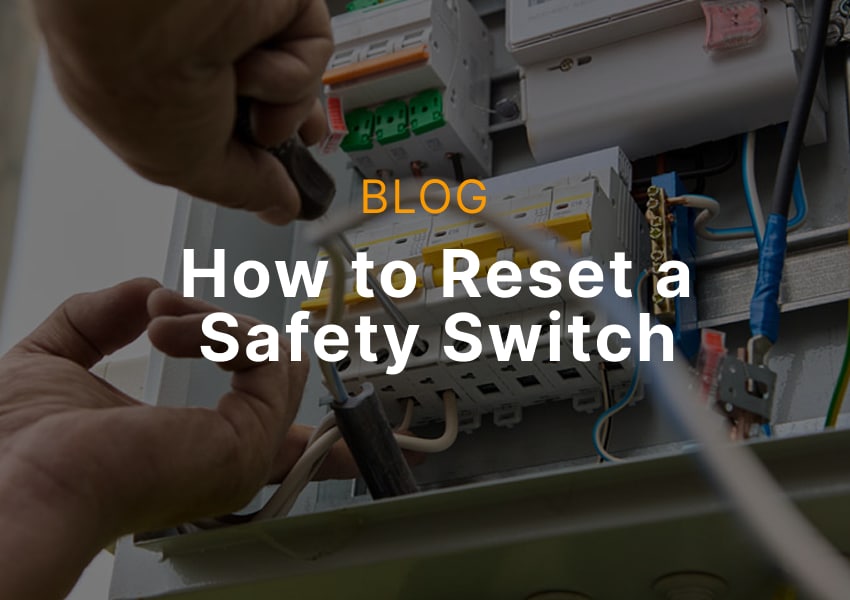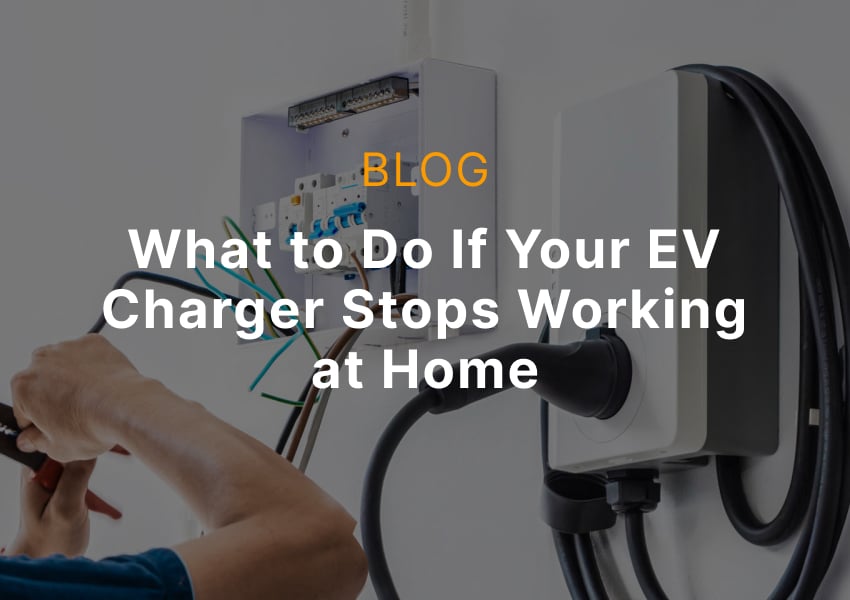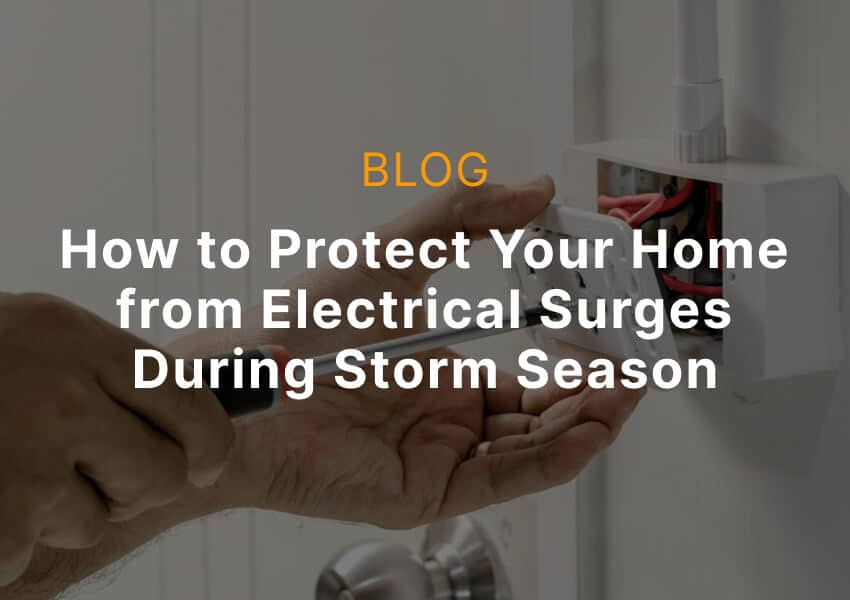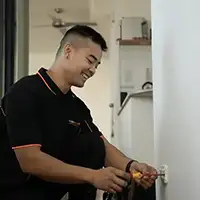If your safety switch keeps tripping, you’re not alone. It’s one of the most common electrical problems in NSW homes, especially after storms, appliance faults, or general wear and tear. Luckily, resetting a safety switch is often simple if you know what to do.
This guide by Powerhub Electrical will show you how to safely reset your RCD (Residual Current Device), what to check if it won’t stay on, and when to call a licensed electrician. All advice is based on Australian wiring rules and relevant NSW safety regulations.
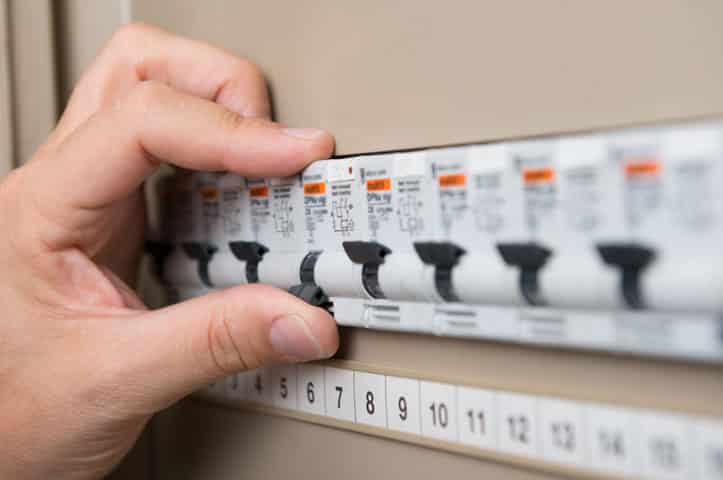
What Is a Safety Switch?
Before you reset it, here’s what a safety switch does and why it matters:
Designed to Save Lives
A safety switch, also known as an RCD, is a legal requirement in all modern NSW homes. It monitors the flow of electricity in a circuit and shuts off power within milliseconds if it detects any leakage, often caused by a fault or electric shock risk.
Unlike a circuit breaker, which protects wiring and appliances, the safety switch’s sole job is to protect people from electrocution.
According to NSW Fair Trading, safety switches must be installed on all power and lighting circuits in new homes or when circuits are added or modified. If your home was built before 2000, it’s worth checking whether your switchboard has proper coverage.
Mandatory in Australian Homes
Under the AS/NZS 3000:2018 Wiring Rules, safety switches are required on:
- Power points
- Lighting circuits
- Pool equipment
- Electric hot water systems
- Any new or modified electrical work
NSW regulations also require safety switches on rental properties, and landlords are responsible for ensuring these devices are tested and functioning.
Where You’ll Find One
Your safety switch is typically located in your main switchboard, often marked as:
- RCD
- Safety Switch
- RCBO (a combined safety switch and breaker)
It’s usually a small switch with a “T” or “Test” button. If it’s flicked down or sitting in the OFF position, it has likely tripped due to a fault.
If you’re not sure which switch is which, a licensed electrician like Powerhub Electrical can inspect your board and label it clearly for future reference.
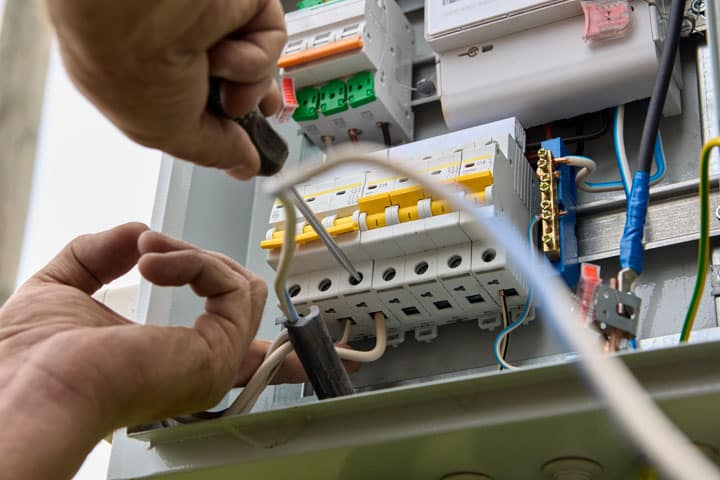
When You Need to Reset It
These are common situations where your safety switch trips and needs resetting.
Sudden Power Loss
If your lights or appliances suddenly cut out, and there’s no sign of a blackout in your area, check your switchboard. A tripped RCD is often the cause, especially if:
- Only part of the house has lost power
- Outdoor areas or a wet room circuit is affected
- You recently used a high-powered appliance like a heater or washing machine
Before resetting, it’s best to unplug everything on the affected circuit to avoid an instant retrip.
After Plugging in a Device
Faulty appliances are a leading cause of trips. If your safety switch trips immediately after plugging something in, that appliance may have a leakage fault. Common culprits include:
- Electric kettles
- Toasters
- Dishwashers
- Fridge compressors
Try removing the appliance and resetting. If it holds, you’ve found the issue.
Post-Storm or Rain Event
Rain can affect external power points, garden lighting, and under-eave sockets, especially if they weren’t weatherproofed correctly. After a heavy storm in Sydney or coastal NSW, moisture may cause earth leakage, tripping your safety switch as soon as the circuit is energised.
In this case, drying the outlet or isolating that circuit until it can be inspected is the safest option. If water is present, do not reset the switch until it’s been tested professionally.
How to Reset a Safety Switch (Step-by-Step)
Resetting a safety switch in your switchboard is something most homeowners in NSW can do, as long as you follow the right steps and take care. If the switch tripped due to a one-time fault like a kettle shorting out or a power point getting wet, a reset will restore your power. But it’s important to do it methodically to avoid further damage or repeated trips.
Step 1 – Locate the RCD
Head to your main switchboard, usually found on an exterior wall, in the garage, laundry, or meter box. Look for a switch labelled:
- RCD
- Safety Switch
- RCBO (a combined safety switch and circuit breaker)
If it’s in the down or OFF position, it has tripped. If none are labelled clearly, and you’re unsure, don’t start flicking switches randomly—call a licensed electrician to identify and label them properly.
Step 2 – Unplug All Appliances
Before attempting a reset, unplug everything connected to the circuit affected. This step is critical. If you try to reset the switch while a faulty appliance is still connected, it’ll trip again immediately.
Unplug items like:
- Kettles
- Fridges
- Washing machines
- Heaters
- Phone chargers
💡 Tip: If you’re not sure which circuit the RCD controls, unplug as much as you can throughout the home. Once you restore power, you can narrow it down.
Step 3 – Reset the Safety Switch
Once everything is unplugged, flick the tripped switch back to the ON position. If it holds, you’ve successfully reset the safety switch. You should hear a firm “click” as it engages.
If it won’t reset or flicks back off immediately, do not keep trying to force it—this could cause further damage or hide an underlying issue (see the next section for what to do).
Step 4 – Plug Appliances Back In One by One
If the switch stays on after the reset, plug appliances back in one at a time. The goal here is to identify which appliance may have caused the trip in the first place.
Here’s how to do it:
- Plug in one appliance
- Wait 5–10 seconds
- If the switch holds, plug in the next
- If it trips again, the last appliance plugged in is likely the issue
Don’t continue using it. Set it aside and have it tested or replaced. In NSW, appliances causing RCD trips may be subject to electrical tagging requirements, especially in rental or commercial properties.
Step 5 – Test the RCD Button (Optional)
If you want to test that the switch is working correctly, press the small “T” or “Test” button on the RCD. It should trip immediately when pressed.
If pressing the test button does nothing, the switch itself may be faulty and no longer offer protection. That’s a sign you need a safety switch replacement—and yes, it must be done by a licensed electrician under NSW law.

What to Do If It Won’t Stay On
Sometimes a safety switch just won’t stay on, even after you’ve unplugged everything. This means the issue is within the circuit or the switchboard, not the appliances. Here are the most common causes and what they might mean for your home.
The appliance is Faulty
Even if you unplugged most items, a faulty appliance left on standby or hardwired into the circuit could be the culprit. Examples include:
- Fridges with internal insulation faults
- Electric hot water systems
- Ceiling fans with exposed wiring
- Hardwired dishwashers or ovens
In NSW rental properties, landlords are responsible for maintaining safe appliances. If you’re a tenant, report ongoing tripping to your agent or property manager immediately.
Water or Moisture Issues
Rainwater, coastal humidity, or even internal plumbing leaks can cause safety switches to trip due to moisture ingress. This is common in:
- Outdoor garden lighting
- Power points near splashbacks or sinks
- Appliances in damp laundries
- Underfloor heating cables
In some cases, water can sit inside wall cavities or conduit, tripping the RCD intermittently. A licensed electrician can use insulation resistance testers to identify where water has compromised a circuit.
Damaged Cabling or Insulation
Old, brittle wires or DIY electrical work can expose live parts, causing leakage to earth that keeps triggering the RCD. You might not see any visible signs, but if the wiring insulation is deteriorated or crushed behind walls or fittings, the switch will trip as soon as power is restored.
This is particularly common in:
- Homes over 30 years old
- Properties with rodents in roof spaces
- Walls where nails or screws have hit hidden cables
This is not something you can or should try to find yourself. If cabling is damaged, a Level 2 electrician will need to isolate and repair the fault properly.
Faulty Safety Switch Unit
Lastly, sometimes it’s the safety switch itself that’s the problem. Like any component, RCDs can degrade with age or fail entirely. If your switch:
- Doesn’t respond to the “Test” button
- Trips constantly with no load
- Feels loose or crackly when switched
…it’s probably due for replacement. Safety switches are mandatory under NSW wiring rules, and it’s worth having one that works exactly as it should.
Safety Switch vs Circuit Breaker
Many people use the terms “safety switch” and “circuit breaker” interchangeably, but they serve completely different purposes, and knowing the difference can help you troubleshoot faster and understand what’s happening inside your switchboard.
RCD Protects People
A safety switch (RCD) is designed to protect you. It trips when it detects current leakage to earth, which could be caused by:
- A person receiving an electric shock
- Water entering an outlet
- Faulty insulation
It usually trips at 30 milliamps, just enough to prevent serious harm or death. In Australia, these devices are mandatory on all final subcircuits in new homes or upgrades, as per the AS/NZS 3000:2018 wiring rules.
Breaker Protects Wiring
A circuit breaker, on the other hand, trips when there’s:
- Too much current (overload)
- A short circuit between active and neutral
Its purpose is to protect your home’s wiring and appliances from overheating, melting, or catching fire. It does not detect electric shocks or current leaking through the body.
What Combined Units Look Like
In newer switchboards, you’ll often see RCBOs, a single switch that combines both functions. These devices:
- Act as both RCD and breaker
- Save space in switchboards
- Offer full circuit and personal protection
If you’re unsure what type you have, a licensed electrician can review your board and upgrade you to fully compliant RCBOs where needed.

When to Call a Licensed Electrician
If the safety switch still won’t stay on, it’s time to stop troubleshooting and get professional help.
A tripping safety switch might seem like a small issue, but if it keeps happening, even after you’ve unplugged everything, it’s a clear sign there’s a deeper electrical fault.
In NSW, it’s not just a matter of safety, it’s also a matter of legal compliance. Only a licensed electrician is authorised to open, test, or modify your switchboard and RCDs under the NSW Home Building Act 1989.
Still Tripping After Reset
If your RCD trips again immediately, even with no appliances plugged in, do not keep resetting it. That’s a sign of:
- Wiring faults
- Moisture inside sockets
- Damaged safety switch hardware
- Faulty insulation behind walls or underground
Continuing to reset a live fault can mask a dangerous problem or damage your circuits further.
Burnt Smell or Buzzing
If you hear buzzing, see scorching near your switchboard, or notice a burning smell from any outlet or the switch itself, turn off the main power and call an electrician immediately. These are signs of:
- Internal arcing
- Overheated connections
- Loose terminals
- Imminent fire risk
This isn’t the time to DIY. A Level 2 electrician will carry out a proper fault diagnosis, insulation resistance testing, and safety switch replacement if needed.
What a Licensed Electrician Will Do
When Powerhub Electrical is called to a property with a tripping RCD, we:
- Isolate circuits and test each one
- Use calibrated test equipment to simulate fault conditions
- Check wiring, outlets, and the switchboard
- Replace worn or non-compliant safety switches
- Provide a Certificate of Compliance for Electrical Work (CCEW), as required under NSW law
If the issue is urgent, we offer same-day service across Sydney and nearby suburbs.
Need Help with a Safety Switch That Won’t Reset?
Stop guessing and get it sorted by a licensed professional.
Whether your safety switch won’t stay on, keeps tripping without warning, or you’re not sure if your home is protected, we’re here to help.
Call Powerhub Electrical in Sydney on 0400 332 331 to book a safety switch inspection or fault test. We’ll find the cause, fix it fast, and make sure your system is safe, compliant, and up to standard.
Frequently Asked Questions
How often should I test my safety switch?
You should test your safety switch every three months by pressing the “Test” button on the device. It should trip instantly. If it doesn’t, or feels spongy, it’s likely faulty and needs replacing. NSW Fair Trading recommends regular testing as part of home safety maintenance.
Is it safe to keep resetting a tripping safety switch?
No. If your safety switch keeps tripping, especially with everything unplugged, there’s a deeper issue. Repeatedly forcing it back on can mask dangerous faults or overload your wiring.
Why does my safety switch trip at night?
Some appliances like fridges, pool pumps, or solar inverters cycle on overnight, triggering an intermittent earth leakage fault. A licensed electrician can help identify the cause using insulation resistance testing.
Can I replace a safety switch myself?
No. Only a licensed electrician can legally replace or install an RCD in NSW. DIY electrical work is not only unsafe—it’s illegal and may void your insurance.
How do I know if I have enough safety switches?
Modern homes should have a separate RCD for every final subcircuit (power, lighting, AC, etc). If you only have one or two covering your whole switchboard, you may need an upgrade to meet current safety standards.

